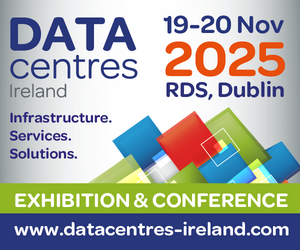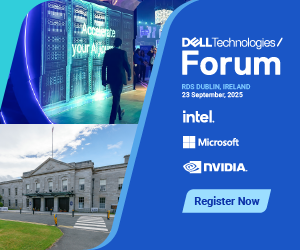One entirely valid approach to the discussion is to take a people point of view, according to Ryan Shanks, head of strategy at Accenture Ireland. “We are working with clients right now on a couple of examples which are about to scale up. There is certainly a real prospect that robots or smart machines will in the near future start to take over tasks that currently constitute jobs or parts of them. On the other hand, it is also clear that the value of such smart machines lies in complementing and assisting human judgment, human-machine collaboration if you will.”
Cloud agent
He points to the example of contact centres and specifically a cloud-delivered autonomous agent called Amelia, from IPsoft, that speaks and reads natural language and learns the requirements and nuances of a service agent in different industries. “These chat windows that we are now encountering on web sites, for example, are interfaces with such agents. They are growing smarter all the time, learning and being modified through experience. If the robot agent slips or is detected as responding incorrectly an alert brings human agent intervention rapidly. So the client is looked after but the significant thing from our point of view is that immediately the human goes back to teach the agent and the system what the interaction should have been or to put in a modified or additional step.

One common view is that although we have lots of smart technology in industry today it is actually not of industrial strength. It needs higher standards, better security and safety, greater resilience for enterprises to depend on it. It also has to stand the test of time. That is partly why we still have SCADA systems, which were designed very differently from today’s rapid and agile software development, for instance, Donagh Buckley, EMC
“As all of that matures, the range of what the machine can handle will extend and improve in quality. But there will always be a role for the experience and judgment of the human and agent. So the rise of the machine in turn means the rise of the real call centre agent to a higher job spec with responsibilities more like troubleshooting, training and management. But one consequence will clearly be fewer jobs at the lower levels.”
Another example Shanks cites is Daqri, an augmented reality developer that has introduced an industrial grade ‘smart helmet’ for field workers and industrial hard-hat environments. This is a wearable human-machine interface with 360 degree cameras, user display like Google Glass and highly accurate professional grade measurement tools.
“The device and user can communicate back to base, to report or to interact with a supervisor or job tutor who can see what the user is seeing and coach remotely. All of the corporate knowledge is centralised and expertise or experience can be so also rather than spending time travelling around with trainees or juniors. Or the user can consult video manuals on the spot but with both hands free. All of this is going to change the nature of many types of industrial work.”
Industrial strength
Donagh Buckley is director of EMC Research Europe, based at the company’s Cork campus. “The sheer pace of development in hardware alone suggests we really only have a glimmering of what the future holds. Today’s smart phone is many times more powerful than the system that put a man on the moon. Add another 30 years and we can hardly imagine the power we will be able to deploy. We are involved with research towards the IoT but more closely with the Industrial Internet and the consortium [IIC] that is leading worldwide efforts to define and set standards for operational technology.
“It is aiming for an open and standards-based common reference architecture that can be universal. One common view is that although we have lots of smart technology in industry today it is actually not of industrial strength. It needs higher standards, better security and safety, greater resilience for enterprises to depend on it. It also has to stand the test of time. That is partly why we still have SCADA systems, which were designed very differently from today’s rapid and agile software development, for instance.”
“To me that industrial strength and shared standards is critical to the industrial internet. Otherwise we will see proprietary standards again and you will not know what you’re getting. We are talking about control systems for everything from a manufacturing line to an airplane to a nuclear power plant. That’s my concern, that we need a whole new level of rigour in how they are designed and developed and implemented. Rapid application development and all that is brilliant, in its place. Today we have much higher levels of functionality that brings with it ever greater complexity, very much including how systems then interact with each other. We all know how systems often outlive the context for which they were designed. If the domain is not self-contained and well understood, the concept of autonomous systems interacting raises huge issues of complexity.”
Industrial focus
Dell R&D today is firmly focussed on the industrial side of the IoT, according to Dermot O’Connell, executive director of OEM Solutions for Dell EMEA. “That is where the excitement is for us right now. Take building and facilities management, for example water, light, electricity and HEVAC and security or whatever, which we think is under-served today. The IoT represents potentially huge opportunities for great ideas and new products, innovation or make something work better than it is today. But in fact the technology is not all that accessible to the people who want to do that.
“That is why our gateway appliance is designed to bring together the IT side of the world with what we call the OT or operational technology side. That is where the machines live, probably networked using Zigbee or CAN bus and other protocols that are just not well known in the traditional IT world. Our gateways and the ecosystem around them are designed to bridge those two worlds, the industrial, very deterministic networks of things like sensors and the Internet and data harvesting and analytics and all of that.”
The Dell gateway securely collects and processes sensor data at the edge of a network. providing the flexibility to perform analytics at the edge while reducing latency for data-based decisions, such as managing energy consumption or triggering a call for preventative equipment maintenance. These are wired/wireless appliances that are rugged, have a wide temperature operational range, can be wall-mounted and accessible, have no moving parts and projected service life of perhaps five years. The point, O’Connell says, is that they offer a pragmatic, practical component as opposed to a great deal of IoT solutions that are overly ambitious with lengthy implementation and complex and often proprietary elements that raise risks and costs.

We have managed to incorporate some management and analytic software so the IoT gateway is remotely manageable and has some in-built edge analytics without needing to bring loads of data back to a central repository unnecessarily, Dermot O’Connell, Dell
“On the other hand, we have managed to incorporate some management and analytic software so the gateway is remotely manageable and has some in-built edge analytics without needing to bring loads of data back to a central repository unnecessarily. The other practical factor is that the minimum order for a Dell gateway appliance is one and delivery will be no more than a couple of weeks. So this is something that is open to anyone and everyone with an IoT project.”
Autonomy fear
That word ‘autonomous’ comes up all the time in any discussion of smart machines. And it provokes fear. Fear of loss of control but also of malevolent interference. Yet security expert Paul Degan, CTO of Cyber Risk International and formerly of both the Irish Army and our National Cyber Security Centre, is wary in the first instance of something much more commonplace.







Subscribers 0
Fans 0
Followers 0
Followers